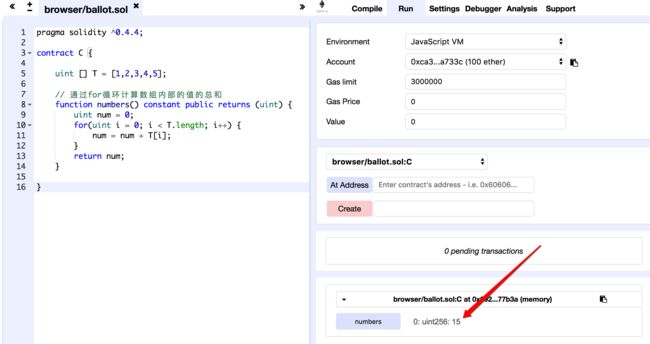学习目标
掌握Arrays的可变不可变的创建
深度理解可变数组和不可变数组之间的区别
二位数组
memory arrays的创建
bytes0 ~ bytes32、bytes与byte[]对比
固定长度的数组(Arrays)
固定长度类型数组的声明
pragma solidity ^0.4.4;
contract C {
// 数组的长度为5,数组里面的存储的值的类型为uint类型
uint [5] T = [1,2,3,4,5];
}
通过length方法获取数组长度遍历数组求总和
pragma solidity ^0.4.4;
contract C {
// 数组的长度为5,数组里面的存储的值的类型为uint类型
uint [5] T = [1,2,3,4,5];
// 通过for循环计算数组内部的值的总和
function numbers() constant public returns (uint) {
uint num = 0;
for(uint i = 0; i < T.length; i++) {
num = num + T[I];
}
return num;
}
}
尝试修改T数组的长度
pragma solidity ^0.4.4;
contract C {
uint [5] T = [1,2,3,4,5];
function setTLength(uint len) public {
T.length = len;
}
}
PS:声明数组时,一旦长度固定,将不能再修改数组的长度。
尝试修改T数组内部值
pragma solidity ^0.4.4;
contract C {
uint [5] T = [1,2,3,4,5];
function setTIndex0Value() public {
T[0] = 10;
}
// 通过for循环计算数组内部的值的总和
function numbers() constant public returns (uint) {
uint num = 0;
for(uint i = 0; i < T.length; i++) {
num = num + T[I];
}
return num;
}
}
T数组初始的内容为[1,2,3,4,5],总和为15 ,当我点击setTIndex0Value方法将第0个索引的1修改为10时,总和为24。
PS:通过一个简单的试验可证明固定长度的数组只是不可修改它的长度,不过可以修改它内部的值,而bytes0 ~ bytes32固定大小字节数组中,大小固定,内容固定,长度和字节均不可修改。
尝试通过push往T数组中添加值
pragma solidity ^0.4.4;
contract C {
uint [5] T = [1,2,3,4,5];
function pushUintToT() public {
T.push(6);
}
}
PS:固定大小的数组不能调用push方法向里面添加存储内容,声明一个固定长度的数组,比如:uint [5] T,数组里面的默认值为[0,0,0,0,0],我们可以通过索引修改里面的值,但是不可修改数组长度以及不可通过push添加存储内容。
可变长度的Arrays
可变长度类型数组的声明
pragma solidity ^0.4.4;
contract C {
uint [] T = [1,2,3,4,5];
function T_Length() constant returns (uint) {
return T.length;
}
}
uint [] T = [1,2,3,4,5],这句代码表示声明了一个可变长度的T数组,因为我们给它初始化了5个无符号整数,所以它的长度默认为5。
通过length方法获取数组长度遍历数组求总和
pragma solidity ^0.4.4;
contract C {
uint [] T = [1,2,3,4,5];
// 通过for循环计算数组内部的值的总和
function numbers() constant public returns (uint) {
uint num = 0;
for(uint i = 0; i < T.length; i++) {
num = num + T[I];
}
return num;
}
}
尝试修改T数组的长度
pragma solidity ^0.4.4;
contract C {
uint [] T = [1,2,3,4,5];
function setTLength(uint len) public {
T.length = len;
}
function TLength() constant returns (uint) {
return T.length;
}
}
PS:对可变长度的数组而言,可随时通过length修改它的长度。
尝试通过push往T数组中添加值
pragma solidity ^0.4.4;
contract C {
uint [] T = [1,2,3,4,5];
function T_Length() constant public returns (uint) {
return T.length;
}
function pushUintToT() public {
T.push(6);
}
function numbers() constant public returns (uint) {
uint num = 0;
for(uint i = 0; i < T.length; i++) {
num = num + T[I];
}
return num;
}
}
PS:当往里面增加一个值,数组的个数就会加1,当求和时也会将新增的数字加起来。
二维数组 - 数组里面放数组
pragma solidity ^0.4.4;
contract C {
uint [2][3] T = [[1,2],[3,4],[5,6]];
function T_len() constant public returns (uint) {
return T.length; // 3
}
}
uint [2][3] T = [[1,2],[3,4],[5,6]]这是一个三行两列的数组,你会发现和Java、C语言等的其它语言中二位数组里面的列和行之间的顺序刚好相反。在其它语言中,上面的内容应该是这么存储uint [2][3] T = [[1,2,3],[4,5,6]]。
上面的数组T是storage类型的数组,对于storage类型的数组,数组里面可以存放任意类型的值(比如:其它数组,结构体,字典/映射等等)。对于memory类型的数组,如果它是一个public类型的函数的参数,那么它里面的内容不能是一个mapping(映射/字典),并且它必须是一个ABI类型。
创建 Memory Arrays
创建一个长度为length的memory类型的数组可以通过new关键字来创建。memory数组一旦创建,它不可通过length修改其长度。
pragma solidity ^0.4.4;
contract C {
function f(uint len) {
uint[] memory a = new uint[](7);
bytes memory b = new bytes(len);
// 在这段代码中 a.length == 7 、b.length == len
a[6] = 8;
}
}
数组字面量 Array Literals / 内联数组 Inline Arrays
pragma solidity ^0.4.4;
contract C {
function f() public {
g([1, 2, 3]);
}
function g(uint[3] _data) public {
// ...
}
}
在上面的代码中,[1, 2, 3]是 uint8[3] memory 类型,因为1、2、3都是uint8类型,他们的个数为3,所以[1, 2, 3]是 uint8[3] memory 类型。但是在g函数中,参数类型为uint[3]类型,显然我们传入的数组类型不匹配,所以会报错。
正确的写法如下:
pragma solidity ^0.4.4;
contract C {
function f() public {
g([uint(1), 2, 3]);
}
function g(uint[3] _data) public {
// ...
}
}
在这段代码中,我们将[1, 2, 3]里面的第0个参数的类型强制转换为uint类型,所以整个[uint(1), 2, 3]的类型就匹配了g函数中的uint[3]类型。
memory类型的固定长度的数组不可直接赋值给storage/memory类型的可变数组
- TypeError: Type uint256[3] memory is not implicitly convertible to expected type uint256[] memory.
pragma solidity ^0.4.4;
contract C {
function f() public {
uint[] memory x = [uint(1), 3, 4];
}
}
browser/ballot.sol:8:9: TypeError: Type uint256[3] memory is not implicitly convertible to expected type uint256[] memory.
uint[] memory x = [uint(1), 3, 4];
^-------------------------------^
- TypeError: Type uint256[3] memory is not implicitly convertible to expected type uint256[] storage pointer
pragma solidity ^0.4.4;
contract C {
function f() public {
uint[] storage x = [uint(1), 3, 4];
}
}
browser/ballot.sol:8:9: TypeError: Type uint256[3] memory is not implicitly convertible to expected type uint256[] storage pointer.
uint[] storage x = [uint(1), 3, 4];
^--------------------------------^
- 正确使用
pragma solidity ^0.4.4;
contract C {
function f() public {
uint[3] memory x = [uint(1), 3, 4];
}
}
创建固定大小字节数组/可变大小字节数组
之前我们的文章中深入讲解了bytes0 ~ bytes32、bytes以及string的使用。bytes0 ~ bytes32创建的是固定字节大小的字节数组,长度不可变,内容不可修改。而string是特殊的可变字节数组,它可以转换为bytes以通过length获取它的字节长度,亦可通过索引修改相对应的字节内容。
创建可变字节数组除了可以通过bytes b = new bytes(len)来创建外,我们亦可以通过byte[] b来进行声明。
而bytes0 ~ bytes32我们可以通过byte[len] b来创建,len 的范围为0 ~ 32。不过这两种方式创建的不可变字节数组有一小点区别,bytes0 ~ bytes32直接声明的不可变字节数组中,长度不可变,内容不可修改。而byte[len] b创建的字节数组中,长度不可变,但是内容可修改。
pragma solidity ^0.4.4;
contract C {
bytes9 a = 0x6c697975656368756e;
byte[9] aa = [byte(0x6c),0x69,0x79,0x75,0x65,0x63,0x68,0x75,0x6e];
byte[] cc = new byte[](10);
function setAIndex0Byte() public {
// 错误,不可修改
a[0] = 0x89;
}
function setAAIndex0Byte() public {
aa[0] = 0x89;
}
function setCC() public {
for(uint i = 0; i < a.length; i++) {
cc.push(a[I]);
}
}
}
总结
本篇文章系统讲解了可变与不可变数组的创建、以及二位数组与其它语言中二位数组的区别,同时讲解了如何创建memory类型的数组以及对bytes0 ~ bytes32、bytes与byte[]对比分析。
原文:Solidity Types - 玩转 Solidity 数组 (Arrays)
作者:黎跃春








